Integration of Carbon Dioxide Removal (CDR) Technology and Artificial Intelligence (AI) in Energy System Optimization
Abstract
:1. Introduction
1.1. Research Background
1.2. Overview of CDR Technology
- Direct Air Capture (DAC)
- Bioenergy Carbon Capture and Storage (BECCS)
- Carbon Sequestration
- Enhanced Weathering
1.3. Research Gap of Past Reviews
2. Integration of “CDR + AI”
2.1. Accurate Carbon Emissions Assessment
2.2. Optimized Energy System Configuration
2.3. Real-Time Monitoring and Scheduling of CDR Facilities
2.4. Mutual Benefits and Mechanisms
3. E Performance Improvement for Energy System
3.1. Efficiency Improvements
3.2. Environmental Impact Reduction
3.3. Economic Feasibility
4. Perspectives and Challenges
5. Conclusions
Author Contributions
Funding
Data Availability Statement
Conflicts of Interest
References
- Honegger, M.; Michaelowa, A.; Roy, J. Potential implications of carbon dioxide removal for the sustainable development goals. Clim. Policy 2021, 21, 678–698. [Google Scholar] [CrossRef]
- Hopster, J. The ethics of disruptive technologies: Towards a general framework. In Proceedings of the International Conference on Disruptive Technologies, Tech Ethics and Artificial Intelligence, Salamanca, Spain, 15–17 September 2021; Springer: Berlin/Heidelberg, Germany, 2021; pp. 133–144. [Google Scholar]
- Yan, Y.; Borhani, T.N.; Subraveti, S.G.; Pai, K.N.; Prasad, V.; Rajendran, A.; Nkulikiyinka, P.; Asibor, J.O.; Zhang, Z.; Shao, D.; et al. Harnessing the power of machine learning for carbon capture, utilisation, and storage (CCUS)—A state-of-the-art review. Energy Environ. Sci. 2021, 14, 6122–6157. [Google Scholar] [CrossRef]
- Terlouw, T.; Bauer, C.; Rosa, L.; Mazzotti, M. Life cycle assessment of carbon dioxide removal technologies: A critical review. Energy Environ. Sci. 2021, 14, 1701–1721. [Google Scholar] [CrossRef]
- Wang, H.; Fu, T.; Du, Y.; Gao, W.; Huang, K.; Liu, Z.; Chandak, P.; Liu, S.; Van Katwyk, P.; Deac, A.; et al. Scientific discovery in the age of artificial intelligence. Nature 2023, 620, 47–60. [Google Scholar] [CrossRef] [PubMed]
- Fuso Nerini, F.; Fawcett, T.; Parag, Y.; Ekins, P. Personal carbon allowances revisited. Nat. Sustain. 2021, 4, 1025–1031. [Google Scholar] [CrossRef]
- Beuttler, C.; Charles, L.; Wurzbacher, J. The role of direct air capture in mitigation of anthropogenic greenhouse gas emissions. Front. Clim. 2019, 1, 10. [Google Scholar] [CrossRef]
- Lackner, K.S. The thermodynamics of direct air capture of carbon dioxide. Energy 2013, 50, 38–46. [Google Scholar] [CrossRef]
- Consoli, C. Bioenergy and Carbon Capture and Storage; Global CCS Institute: Washington, DC, USA, 2019. [Google Scholar]
- Withey, P.; Johnston, C.; Guo, J. Quantifying the global warming potential of carbon dioxide emissions from bioenergy with carbon capture and storage. Renew. Sustain. Energy Rev. 2019, 115, 109408. [Google Scholar] [CrossRef]
- Salehi, H.; Burgueño, R. Emerging artificial intelligence methods in structural engineering. Eng. Struct. 2018, 171, 170–189. [Google Scholar] [CrossRef]
- Rocha, H.R.; Honorato, I.H.; Fiorotti, R.; Celeste, W.C.; Silvestre, L.J.; Silva, J.A. An Artificial Intelligence based scheduling algorithm for demand-side energy management in Smart Homes. Appl. Energy 2021, 282, 116145. [Google Scholar] [CrossRef]
- Hepburn, C.; Adlen, E.; Beddington, J.; Carter, E.A.; Fuss, S.; Mac Dowell, N.; Minx, J.C.; Smith, P.; Williams, C.K. The technological and economic prospects for CO2 utilization and removal. Nature 2019, 575, 87–97. [Google Scholar] [CrossRef]
- Erans, M.; Sanz-Pérez, E.S.; Hanak, D.P.; Clulow, Z.; Reiner, D.M.; Mutch, G.A. Direct air capture: Process technology, techno-economic and socio-political challenges. Energy Environ. Sci. 2022, 15, 1360–1405. [Google Scholar] [CrossRef]
- Viebahn, P.; Scholz, A.; Zelt, O. The potential role of direct air capture in the German energy research program—Results of a multi-dimensional analysis. Energies 2019, 12, 3443. [Google Scholar] [CrossRef]
- Marcucci, A.; Kypreos, S.; Panos, E. The road to achieving the long-term Paris targets: Energy transition and the role of direct air capture. Clim. Chang. 2017, 144, 181–193. [Google Scholar] [CrossRef]
- Rogelj, J.; Luderer, G.; Pietzcker, R.C.; Kriegler, E.; Schaeffer, M.; Krey, V.; Riahi, K. Energy system transformations for limiting end-of-century warming to below 1.5 °C. Nat. Clim. Chang. 2015, 5, 519–527. [Google Scholar] [CrossRef]
- Chen, C.; Tavoni, M. Direct air capture of CO2 and climate stabilization: A model based assessment. Clim. Chang. 2013, 118, 59–72. [Google Scholar] [CrossRef]
- Mishra, A.; Kumar, M.; Medhi, K.; Thakur, I.S. Biomass energy with carbon capture and storage (BECCS). In Current Developments in Biotechnology and Bioengineering; Elsevier: Amsterdam, The Netherlands, 2020; pp. 399–427. [Google Scholar]
- Restrepo-Valencia, S.; Walter, A. Techno-economic assessment of bio-energy with carbon capture and storage systems in a typical sugarcane mill in Brazil. Energies 2019, 12, 1129. [Google Scholar] [CrossRef]
- Mosleh, M.H.; Sedighi, M.; Babaei, M.; Turner, M. Geological sequestration of carbon dioxide. In Managing Global Warming; Elsevier: Amsterdam, The Netherlands, 2019; pp. 487–500. [Google Scholar]
- Goll, D.S.; Ciais, P.; Amann, T.; Buermann, W.; Chang, J.; Eker, S.; Hartmann, J.; Janssens, I.; Li, W.; Obersteiner, M.; et al. Potential CO2 removal from enhanced weathering by ecosystem responses to powdered rock. Nat. Geosci. 2021, 14, 545–549. [Google Scholar] [CrossRef]
- Li, J.; Hitch, M.; Power, I.M.; Pan, Y. Integrated mineral carbonation of ultramafic mine deposits—A review. Minerals 2018, 8, 147. [Google Scholar] [CrossRef]
- Khanna, N.Z.; Zhang, J.; Lu, H.; Feng, W.; Johnson-Wang, M.; Zhou, N. Conceptualizing demand-side technological and social innovations in modeling pathways to carbon neutrality. Energy Res. Soc. Sci. 2023, 100, 103115. [Google Scholar] [CrossRef]
- Chen, X.; Wu, X.; Lee, K.Y. The mutual benefits of renewables and carbon capture: Achieved by an artificial intelligent scheduling strategy. Energy Convers. Manag. 2021, 233, 113856. [Google Scholar] [CrossRef]
- Liao, M.; Lan, K.; Yao, Y. Sustainability implications of artificial intelligence in the chemical industry: A conceptual framework. J. Ind. Ecol. 2022, 26, 164–182. [Google Scholar] [CrossRef]
- Wang, Y.; Ciais, P.; Broquet, G.; Bréon, F.-M.; Oda, T.; Lespinas, F.; Meijer, Y.; Loescher, A.; Janssens-Maenhout, G.; Zheng, B.; et al. A global map of emission clumps for future monitoring of fossil fuel CO2 emissions from space. Earth Syst. Sci. Data 2019, 11, 687–703. [Google Scholar] [CrossRef]
- Masood, A.; Ahmad, K. A review on emerging artificial intelligence (AI) techniques for air pollution forecasting: Fundamentals, application and performance. J. Clean. Prod. 2021, 322, 129072. [Google Scholar] [CrossRef]
- Ağbulut, Ü. Forecasting of transportation-related energy demand and CO2 emissions in Turkey with different machine learning algorithms. Sustain. Prod. Consum. 2022, 29, 141–157. [Google Scholar] [CrossRef]
- Ghahramani, M.; Pilla, F. Analysis of carbon dioxide emissions from road transport using taxi trips. IEEE Access 2021, 9, 98573–98580. [Google Scholar] [CrossRef]
- Fascista, A. Toward integrated large-scale environmental monitoring using WSN/UAV/Crowdsensing: A review of applications, signal processing, and future perspectives. Sensors 2022, 22, 1824. [Google Scholar] [CrossRef]
- Riahi, K.; Van Vuuren, D.P.; Kriegler, E.; Edmonds, J.; O’neill, B.C.; Fujimori, S.; Bauer, N.; Calvin, K.; Dellink, R.; Fricko, O.; et al. The Shared Socioeconomic Pathways and their energy, land use, and greenhouse gas emissions implications: An overview. Glob. Environ. Chang. 2017, 42, 153–168. [Google Scholar] [CrossRef]
- Leue, C.; Wenig, M.; Wagner, T.; Klimm, O.; Platt, U.; Jähne, B. Quantitative analysis of NO x emissions from Global Ozone Monitoring Experiment satellite image sequences. J. Geophys. Res. Atmos. 2001, 106, 5493–5505. [Google Scholar] [CrossRef]
- Zhang, X.; Shu, K.; Rajkumar, S.; Sivakumar, V. Research on deep integration of application of artificial intelligence in environmental monitoring system and real economy. Environ. Impact Assess. Rev. 2021, 86, 106499. [Google Scholar] [CrossRef]
- Syafrudin, M.; Alfian, G.; Fitriyani, N.L.; Rhee, J. Performance analysis of IoT-based sensor, big data processing, and machine learning model for real-time monitoring system in automotive manufacturing. Sensors 2018, 18, 2946. [Google Scholar] [CrossRef]
- Park, J.; Yang, B. GIS-enabled digital twin system for sustainable evaluation of carbon emissions: A case study of Jeonju city, south Korea. Sustainability 2020, 12, 9186. [Google Scholar] [CrossRef]
- Requia, W.J.; Roig, H.L.; Koutrakis, P.; Adams, M.D. Modeling spatial patterns of traffic emissions across 5570 municipal districts in Brazil. J. Clean. Prod. 2017, 148, 845–853. [Google Scholar] [CrossRef]
- Cui, Q.; Jia, Z.-k. Transfer of embodied carbon emissions from provincial transportation industry in China. Multimodal Transp. 2023, 2, 100105. [Google Scholar] [CrossRef]
- Chen, X.; Wu, X. The roles of carbon capture, utilization and storage in the transition to a low-carbon energy system using a stochastic optimal scheduling approach. J. Clean. Prod. 2022, 366, 132860. [Google Scholar] [CrossRef]
- Huang, Q.; Amin, W.; Umer, K.; Gooi, H.B.; Eddy, F.Y.S.; Afzal, M.; Shahzadi, M.; Khan, A.A.; Ahmad, S.A. A review of transactive energy systems: Concept and implementation. Energy Rep. 2021, 7, 7804–7824. [Google Scholar] [CrossRef]
- Jiang, A.; Yuan, H.; Li, D.; Tian, J. Key technologies of ubiquitous power Internet of Things-aided smart grid. J. Renew. Sustain. Energy 2019, 11, 062702. [Google Scholar] [CrossRef]
- Şerban, A.C.; Lytras, M.D. Artificial intelligence for smart renewable energy sector in europe—Smart energy infrastructures for next generation smart cities. IEEE Access 2020, 8, 77364–77377. [Google Scholar] [CrossRef]
- Cheng, L.; Yu, T. A new generation of AI: A review and perspective on machine learning technologies applied to smart energy and electric power systems. Int. J. Energy Res. 2019, 43, 1928–1973. [Google Scholar] [CrossRef]
- Wu, C.-J.; Raghavendra, R.; Gupta, U.; Acun, B.; Ardalani, N.; Maeng, K.; Chang, G.; Aga, F.; Huang, J.; Bai, C.; et al. Sustainable ai: Environmental implications, challenges and opportunities. Proc. Mach. Learn. Syst. 2022, 4, 795–813. [Google Scholar]
- Migo-Sumagang, M.V.; Aviso, K.B.; Foo, D.C.; Short, M.; Nair, P.N.S.B.; Tan, R.R. Optimization and decision support models for deploying negative emissions technologies. PLoS Sustain. Transform. 2023, 2, e0000059. [Google Scholar] [CrossRef]
- Tariq, R.; Cetina-Quiñones, A.; Cardoso-Fernández, V.; Daniela-Abigail, H.-L.; Soberanis, M.E.; Bassam, A.; De Lille, M.V. Artificial intelligence assisted technoeconomic optimization scenarios of hybrid energy systems for water management of an isolated community. Sustain. Energy Technol. Assess. 2021, 48, 101561. [Google Scholar] [CrossRef]
- Zhang, Z.; Yang, X.; Yang, L.; Wang, Z.; Huang, Z.; Wang, X.; Mei, L. Optimal configuration of double carbon energy system considering climate change. Energy 2023, 283, 129188. [Google Scholar] [CrossRef]
- Menos-Aikateriniadis, C.; Lamprinos, I.; Georgilakis, P.S. Particle swarm optimization in residential demand-side management: A review on scheduling and control algorithms for demand response provision. Energies 2022, 15, 2211. [Google Scholar] [CrossRef]
- Fasogbon, S.K.; Shaibu, S.A. Energy Grid Optimization Using Deep Machine Learning: A Review of Challenges and Opportunities. Preprints 2023, 2023061874. [Google Scholar] [CrossRef]
- Strielkowski, W.; Vlasov, A.; Selivanov, K.; Muraviev, K.; Shakhnov, V. Prospects and Challenges of the Machine Learning and Data-Driven Methods for the Predictive Analysis of Power Systems: A Review. Energies 2023, 16, 4025. [Google Scholar] [CrossRef]
- Wang, H.; Lei, Z.; Zhang, X.; Zhou, B.; Peng, J. A review of deep learning for renewable energy forecasting. Energy Convers. Manag. 2019, 198, 111799. [Google Scholar] [CrossRef]
- Rahman, M.M.; Shakeri, M.; Tiong, S.K.; Khatun, F.; Amin, N.; Pasupuleti, J.; Hasan, M.K. Prospective methodologies in hybrid renewable energy systems for energy prediction using artificial neural networks. Sustainability 2021, 13, 2393. [Google Scholar] [CrossRef]
- Ying, C.; Wang, W.; Yu, J.; Li, Q.; Yu, D.; Liu, J. Deep learning for renewable energy forecasting: A taxonomy, and systematic literature review. J. Clean. Prod. 2022, 384, 135414. [Google Scholar] [CrossRef]
- Ahmad, T.; Zhang, H.; Yan, B. A review on renewable energy and electricity requirement forecasting models for smart grid and buildings. Sustain. Cities Soc. 2020, 55, 102052. [Google Scholar] [CrossRef]
- Perera, A.; Nik, V.M.; Wickramasinghe, P.; Scartezzini, J.-L. Redefining energy system flexibility for distributed energy system design. Appl. Energy 2019, 253, 113572. [Google Scholar] [CrossRef]
- Alotaibi, I.; Abido, M.A.; Khalid, M.; Savkin, A.V. A comprehensive review of recent advances in smart grids: A sustainable future with renewable energy resources. Energies 2020, 13, 6269. [Google Scholar] [CrossRef]
- Layton, P. Fighting Artificial Intelligence Battles: Operational Concepts for Future AI-Enabled Wars. Network 2021, 4, 1–100. [Google Scholar]
- Regufe, M.J.; Pereira, A.; Ferreira, A.F.; Ribeiro, A.M.; Rodrigues, A.E. Current developments of carbon capture storage and/or utilization–looking for net-zero emissions defined in the Paris agreement. Energies 2021, 14, 2406. [Google Scholar] [CrossRef]
- Almalawi, A.; Alsolami, F.; Khan, A.I.; Alkhathlan, A.; Fahad, A.; Irshad, K.; Qaiyum, S.; Alfakeeh, A.S. An IoT based system for magnify air pollution monitoring and prognosis using hybrid artificial intelligence technique. Environ. Res. 2022, 206, 112576. [Google Scholar] [CrossRef]
- Song, G.; Ai, Z.; Liu, Z.; Zhang, G. A systematic literature review on smart and personalized ventilation using CO2 concentration monitoring and control. Energy Rep. 2022, 8, 7523–7536. [Google Scholar] [CrossRef]
- Himeur, Y.; Elnour, M.; Fadli, F.; Meskin, N.; Petri, I.; Rezgui, Y.; Bensaali, F.; Amira, A. AI-big data analytics for building automation and management systems: A survey, actual challenges and future perspectives. Artif. Intell. Rev. 2023, 56, 4929–5021. [Google Scholar] [CrossRef]
- Zhou, Q.; Chan, C.W.; Tontiwachiwuthikul, P. A monitoring and diagnostic expert system for carbon dioxide capture. Expert Syst. Appl. 2009, 36, 1621–1631. [Google Scholar] [CrossRef]
- Sleiti, A.K.; Al-Ammari, W.A.; Vesely, L.; Kapat, J.S. Carbon dioxide transport pipeline systems: Overview of technical characteristics, safety, integrity and cost, and potential application of digital twin. J. Energy Resour. Technol. 2022, 144, 092106. [Google Scholar] [CrossRef]
- Ahmad, T.; Madonski, R.; Zhang, D.; Huang, C.; Mujeeb, A. Data-driven probabilistic machine learning in sustainable smart energy/smart energy systems: Key developments, challenges, and future research opportunities in the context of smart grid paradigm. Renew. Sustain. Energy Rev. 2022, 160, 112128. [Google Scholar] [CrossRef]
- Xing, Z.; Huang, J.; Wang, J. Unleashing the potential: Exploring the nexus between low-carbon digital economy and regional economic-social development in China. J. Clean. Prod. 2023, 413, 137552. [Google Scholar] [CrossRef]
- Ahmad, T.; Zhang, D.; Huang, C.; Zhang, H.; Dai, N.; Song, Y.; Chen, H. Artificial intelligence in sustainable energy industry: Status Quo, challenges and opportunities. J. Clean. Prod. 2021, 289, 125834. [Google Scholar] [CrossRef]
- Zhou, Q.; Chan, C.; Tontiwachiwuthikul, P. Development of an Intelligent System for Monitoring and Diagnosis of the Carbon Dioxide Capture Process. J. Environ. Inform. 2011, 18, 75–83. [Google Scholar] [CrossRef]
- James, P.; Astoria, R.; Castor, T.; Hudspeth, C.; Olstinske, D.; Ward, J. Smart Cities: Fundamental Concepts. In Handbook of Smart Cities; Augusto, J., Ed.; Springer: Cham, Switzerland, 2020. [Google Scholar] [CrossRef]
- Hannan, M.; Al-Shetwi, A.Q.; Ker, P.J.; Begum, R.; Mansor, M.; Rahman, S.; Dong, Z.; Tiong, S.; Mahlia, T.I.; Muttaqi, K. Impact of renewable energy utilization and artificial intelligence in achieving sustainable development goals. Energy Rep. 2021, 7, 5359–5373. [Google Scholar] [CrossRef]
- Napoli, F. Corporate Digital Responsibility: A Board of Directors May Encourage the Environmentally Responsible Use of Digital Technology and Data: Empirical Evidence from Italian Publicly Listed Companies. Sustainability 2023, 15, 2539. [Google Scholar] [CrossRef]
- Chen, C.; Hu, Y.; Karuppiah, M.; Kumar, P.M. Artificial intelligence on economic evaluation of energy efficiency and renewable energy technologies. Sustain. Energy Technol. Assess. 2021, 47, 101358. [Google Scholar] [CrossRef]
- Xi, H.; Wu, X.; Chen, X.; Sha, P. Artificial intelligent based energy scheduling of steel mill gas utilization system towards carbon neutrality. Appl. Energy 2021, 295, 117069. [Google Scholar] [CrossRef]
- Jackson, S.; Brodal, E. Optimization of the energy consumption of a carbon capture and sequestration related carbon dioxide compression processes. Energies 2019, 12, 1603. [Google Scholar] [CrossRef]
- Tagliabue, L.C.; Cecconi, F.R.; Rinaldi, S.; Ciribini, A.L.C. Data driven indoor air quality prediction in educational facilities based on IoT network. Energy Build. 2021, 236, 110782. [Google Scholar] [CrossRef]
- Omrany, H.; Al-Obaidi, K.M.; Husain, A.; Ghaffarianhoseini, A. Digital twins in the construction industry: A comprehensive review of current implementations, enabling technologies, and future directions. Sustainability 2023, 15, 10908. [Google Scholar] [CrossRef]
- Kushwaha, O.S.; Uthayakumar, H.; Kumaresan, K. Modeling of carbon dioxide fixation by microalgae using hybrid artificial intelligence (AI) and fuzzy logic (FL) methods and optimization by genetic algorithm (GA). Environ. Sci. Pollut. Res. 2023, 30, 24927–24948. [Google Scholar] [CrossRef]
- Hong, T.; Wang, Z.; Luo, X.; Zhang, W. State-of-the-art on research and applications of machine learning in the building life cycle. Energy Build. 2020, 212, 109831. [Google Scholar] [CrossRef]
- Kunduru, A.R. Artificial intelligence usage in cloud application performance improvement. Cent. Asian J. Math. Theory Comput. Sci. 2023, 4, 42–47. [Google Scholar]
- Liu, Z.; Wang, W.; Chen, Y.; Wang, L.; Guo, Z.; Yang, X.; Yan, J. Solar harvest: Enhancing carbon sequestration and energy efficiency in solar greenhouses with PVT and GSHP systems. Renew. Energy 2023, 211, 112–125. [Google Scholar] [CrossRef]
- Wang, L.; Huang, X.; Babaei, M.; Liu, Z.; Yang, X.; Yan, J. Full-scale utilization of geothermal energy: A high-efficiency CO2 hybrid cogeneration system with low-temperature waste heat. J. Clean. Prod. 2023, 403, 136866. [Google Scholar] [CrossRef]
- Hai, T.; Alsharif, S.; Dhahad, H.A.; Attia, E.-A.; Shamseldin, M.A.; Ahmed, A.N. The evolutionary artificial intelligence-based algorithm to find the minimum GHG emission via the integrated energy system using the MSW as fuel in a waste heat recovery plant. Sustain. Energy Technol. Assess. 2022, 53, 102531. [Google Scholar] [CrossRef]
- Gupta, S.; Li, L. The potential of machine learning for enhancing CO2 sequestration, storage, transportation, and utilization-based processes: A brief perspective. JOM 2022, 74, 414–428. [Google Scholar] [CrossRef]
- Godin, J.; Liu, W.; Ren, S.; Xu, C.C. Advances in recovery and utilization of carbon dioxide: A brief review. J. Environ. Chem. Eng. 2021, 9, 105644. [Google Scholar] [CrossRef]
- Woo, J.; Asutosh, A.T.; Li, J.; Ryor, W.D.; Kibert, C.J.; Shojaei, A. Blockchain: A theoretical framework for better application of carbon credit acquisition to the building sector. In Construction Research Congress 2020; American Society of Civil Engineers Reston: Reston, VA, USA, 2020; pp. 885–894. [Google Scholar]
- Yang, M.; Chen, L.; Wang, J.; Msigwa, G.; Osman, A.I.; Fawzy, S.; Rooney, D.W.; Yap, P.-S. Circular economy strategies for combating climate change and other environmental issues. Environ. Chem. Lett. 2023, 21, 55–80. [Google Scholar] [CrossRef]
- Jiutian, Z.; Zhiyong, W.; Jia-Ning, K.; Xiangjing, S.; Dong, X. Several key issues for CCUS development in China targeting carbon neutrality. Carbon Neutrality 2022, 1, 17. [Google Scholar] [CrossRef]
- Ghiasi, M.; Wang, Z.; Mehrandezh, M.; Jalilian, S.; Ghadimi, N. Evolution of smart grids towards the Internet of energy: Concept and essential components for deep decarbonisation. IET Smart Grid 2023, 6, 86–102. [Google Scholar] [CrossRef]
- Aguilar, J.; Garces-Jimenez, A.; R-moreno, M.; García, R. A systematic literature review on the use of artificial intelligence in energy self-management in smart buildings. Renew. Sustain. Energy Rev. 2021, 151, 111530. [Google Scholar] [CrossRef]
- Parson, E.A.; Buck, H.J. Large-scale carbon dioxide removal: The problem of phasedown. Glob. Environ. Politics 2020, 20, 70–92. [Google Scholar] [CrossRef]
- Gładysz, P.; Sowiżdżał, A.; Miecznik, M.; Hacaga, M.; Pająk, L. Techno-economic assessment of a combined heat and power plant integrated with carbon dioxide removal technology: A case study for Central Poland. Energies 2020, 13, 2841. [Google Scholar] [CrossRef]
- Alsarhan, L.M.; Alayyar, A.S.; Alqahtani, N.B.; Khdary, N.H. Circular carbon economy (CCE): A way to invest CO2 and protect the environment, a review. Sustainability 2021, 13, 11625. [Google Scholar] [CrossRef]

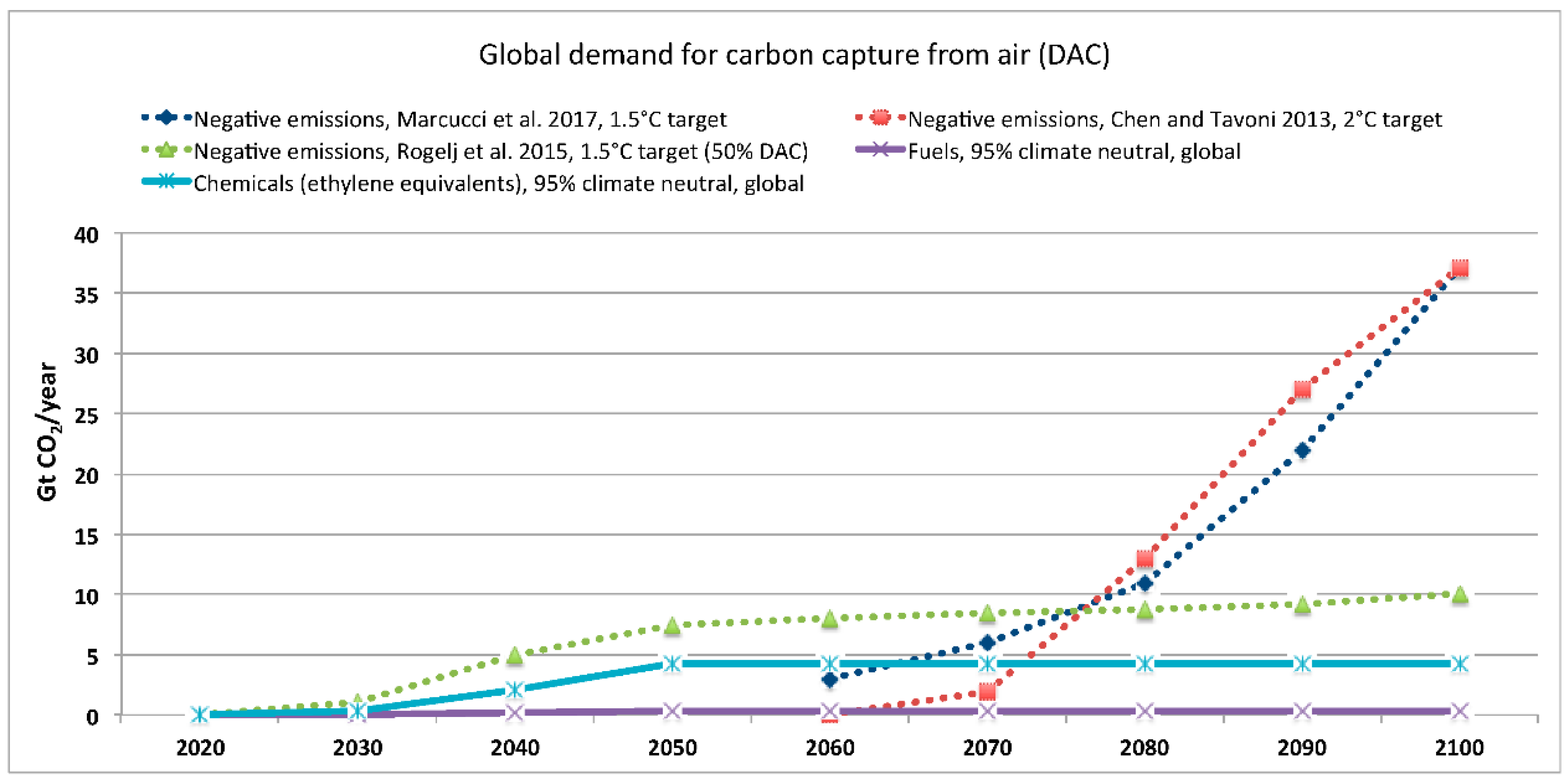
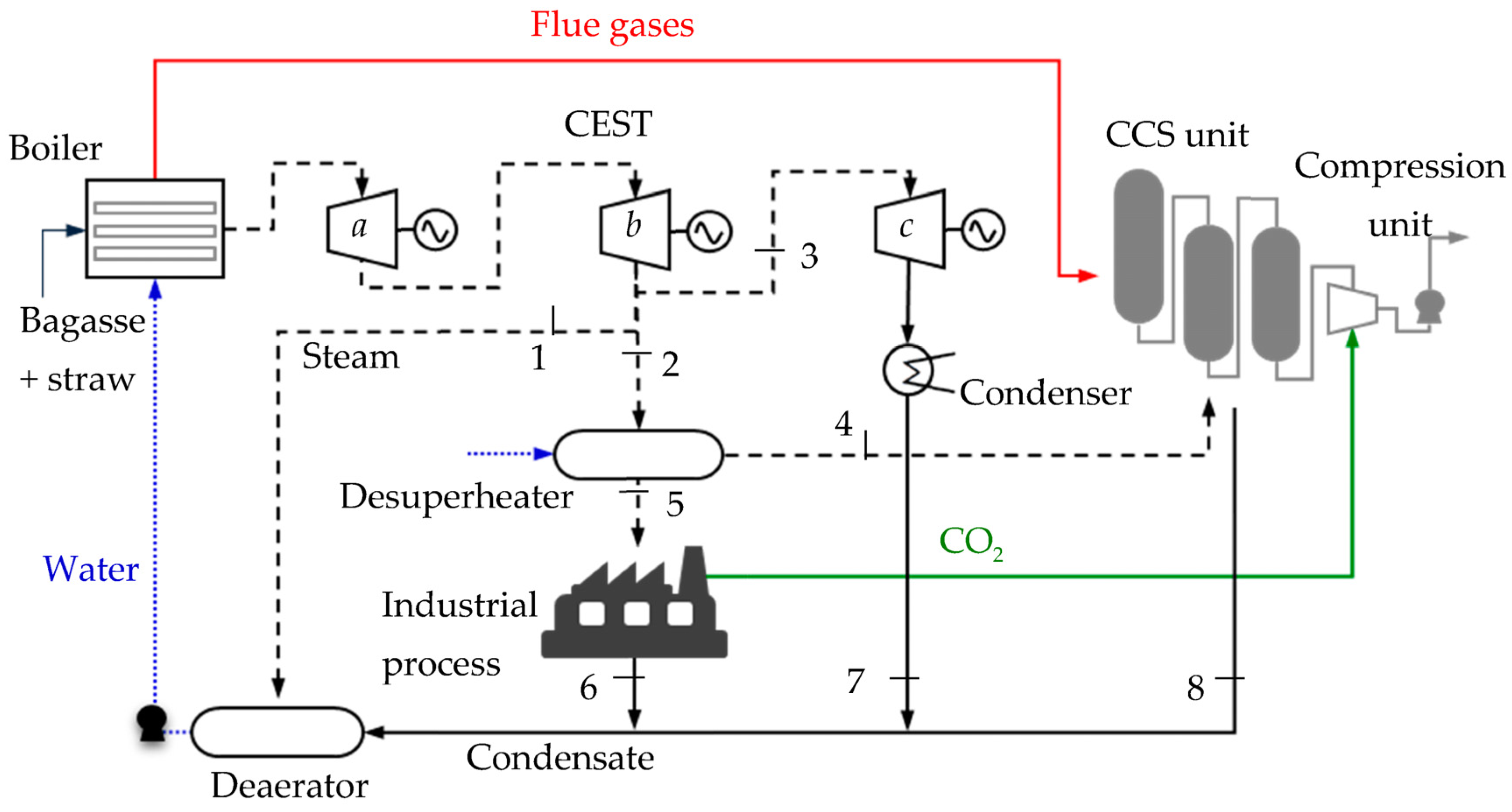
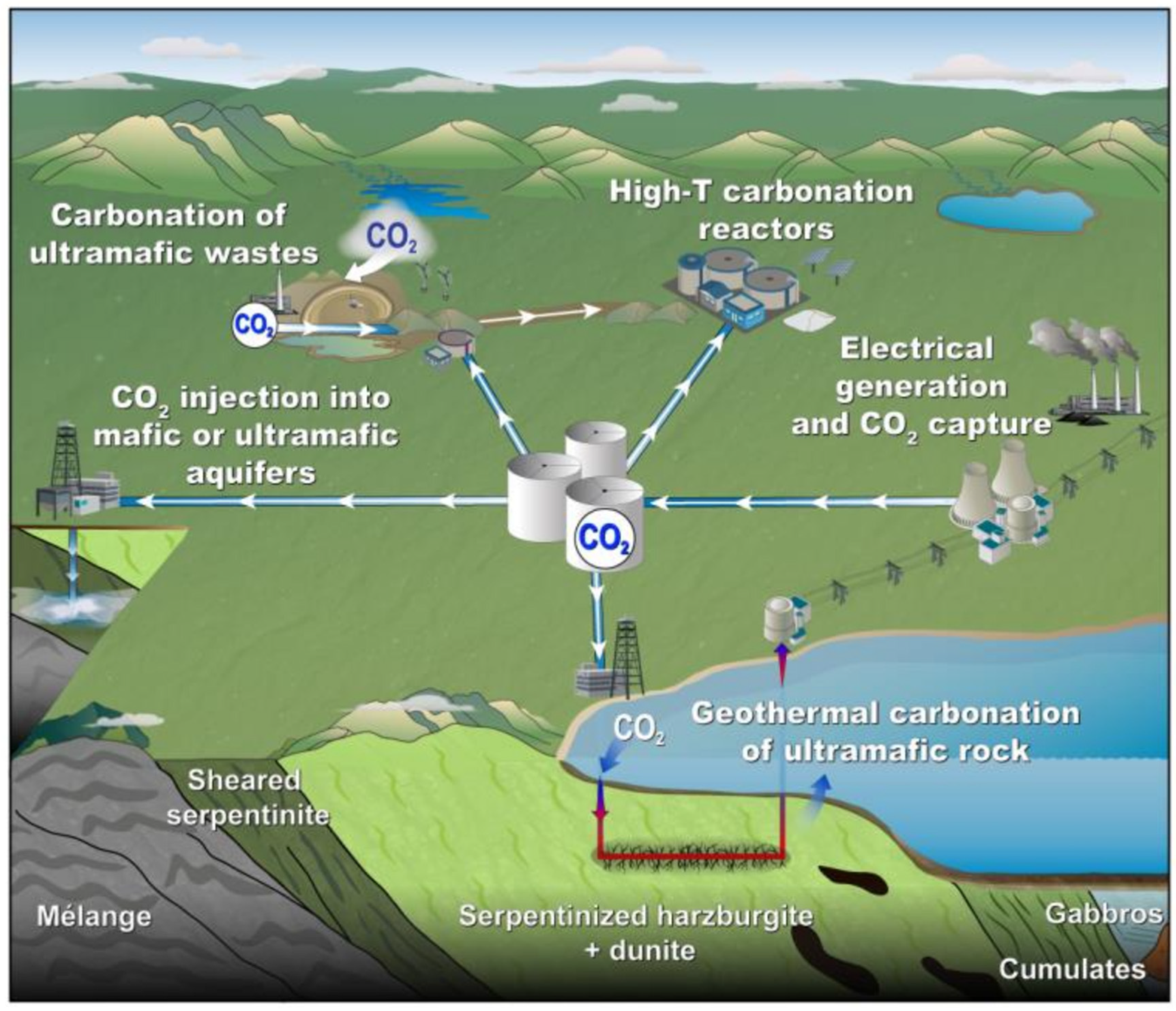
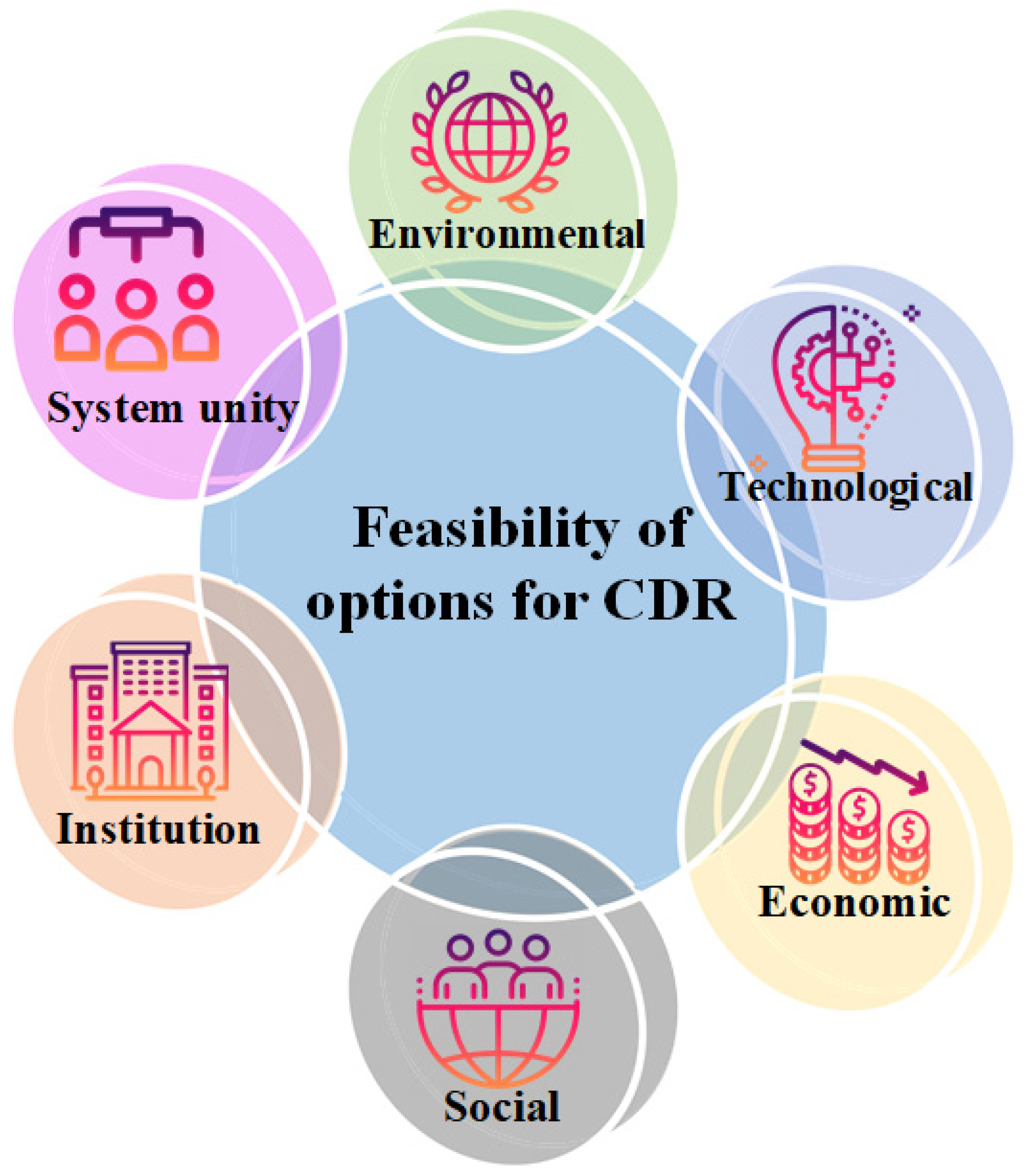
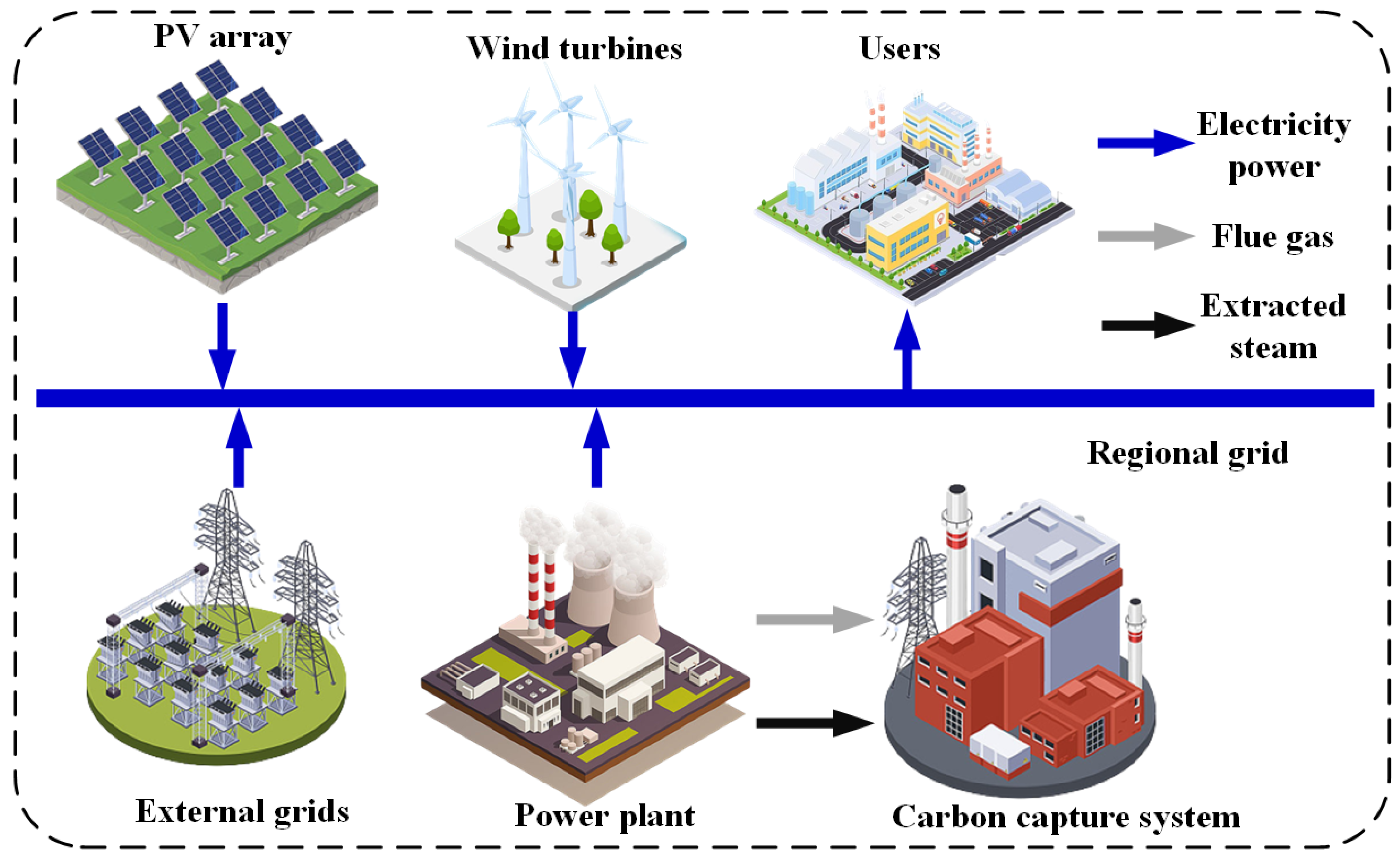
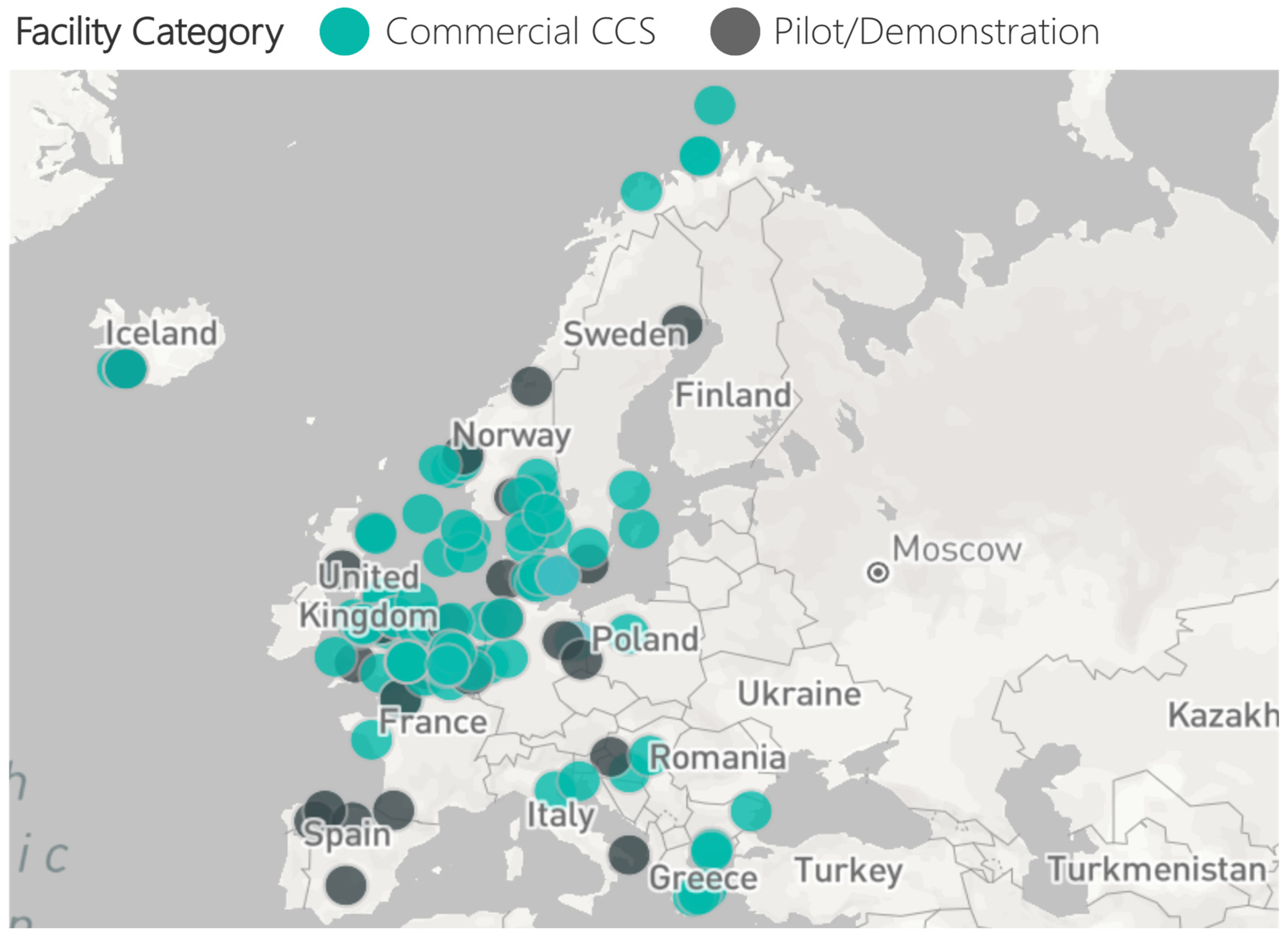
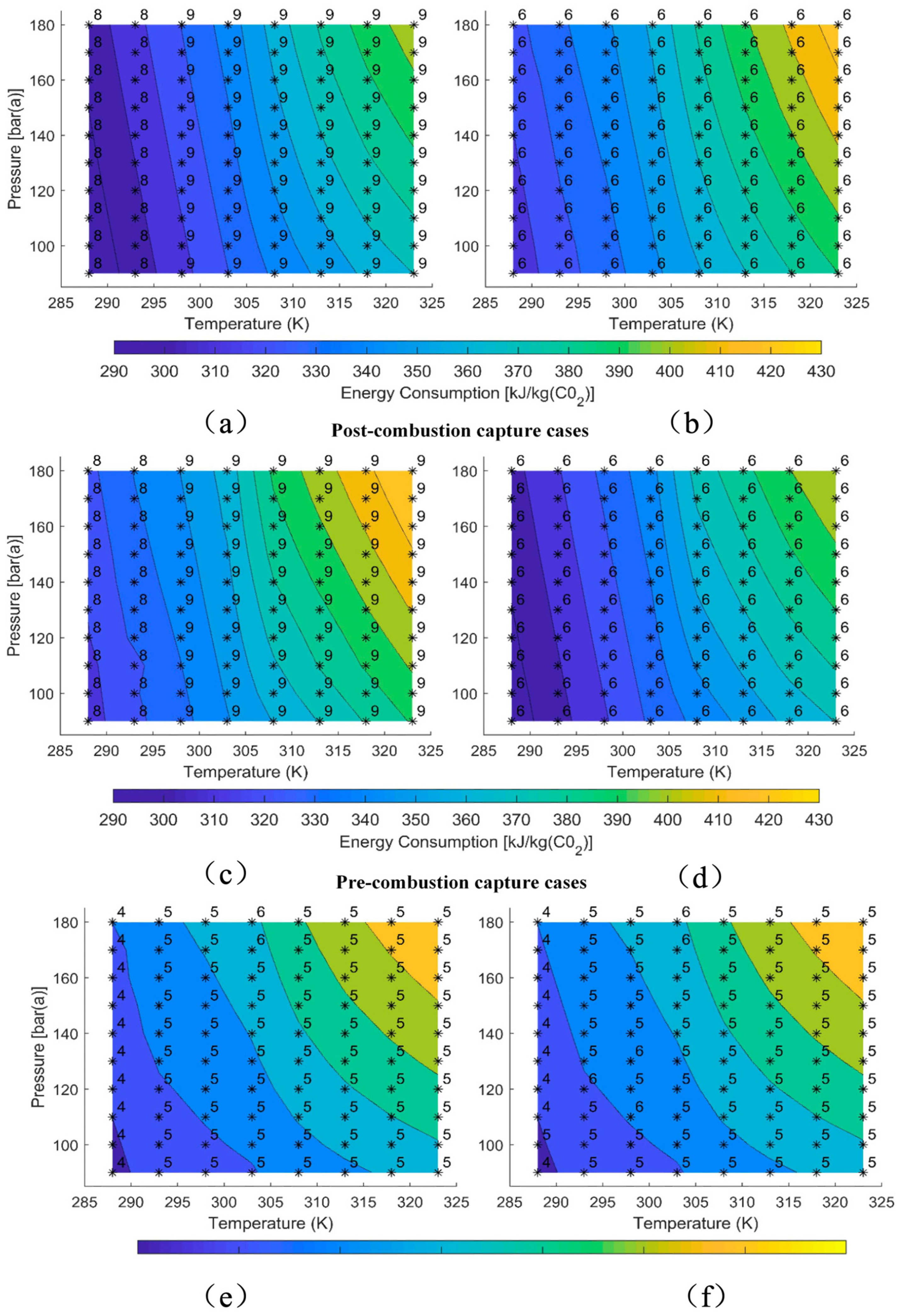

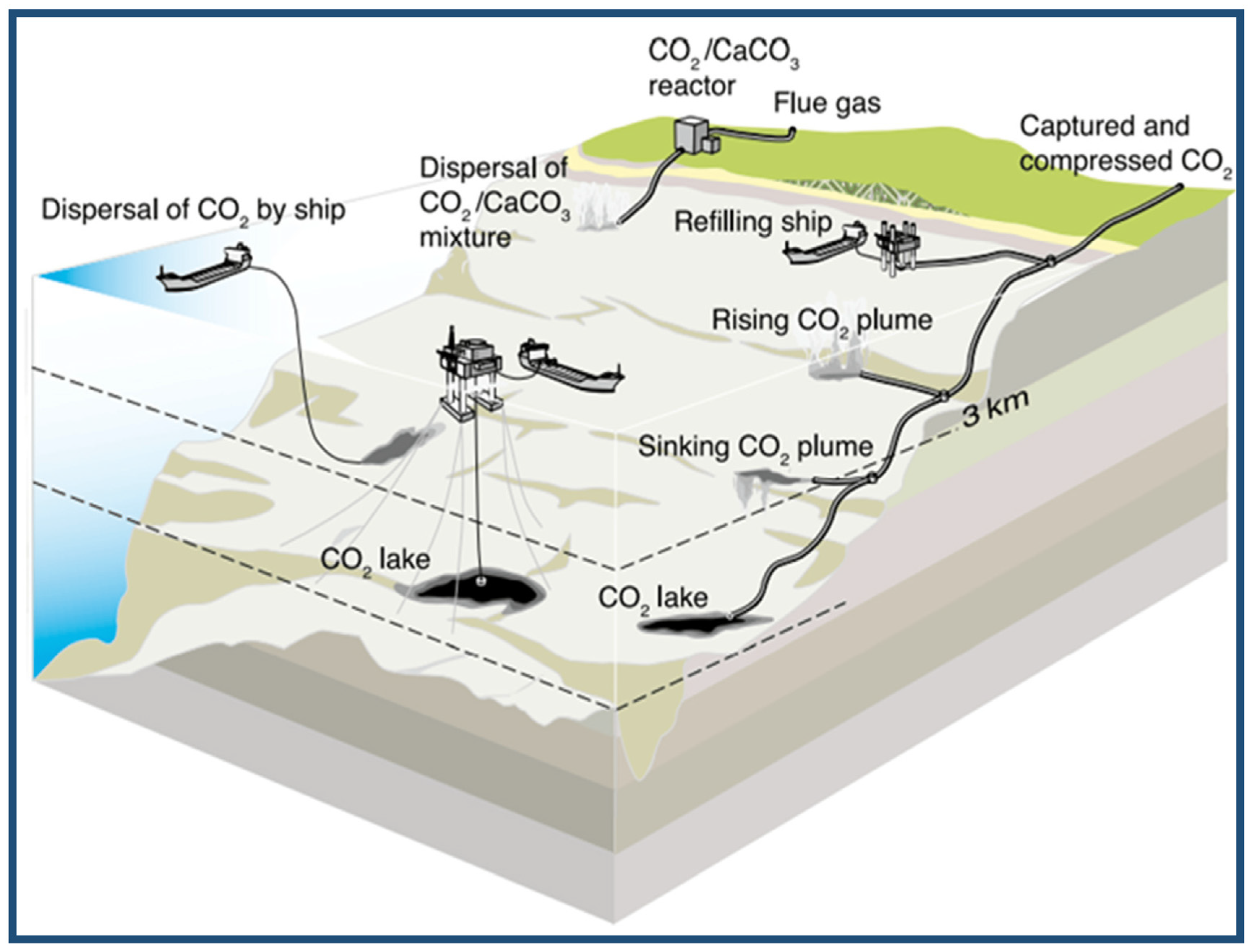
| Technologies | Advantages | Disadvantages |
|---|---|---|
| DAC | 1. It can capture carbon dioxide from the air at any location. 2. Potential for large-scale carbon capture and storage. | 1. It requires significant amounts of electricity and energy. 2. Relatively high cost compared to traditional methods. |
| BECCS | 1. It utilizes biomass feedstocks, which can be renewable and sustainable. 2. It can be integrated with existing power plants or industrial facilities. | 1. It requires large areas of land to cultivate biomass feedstocks. 2. It competes with land use for food production and conservation efforts. |
| Carbon Sequestration | 1. It enhances soil fertility and promotes sustainable land management practices 2. It can contribute to the development of carbon offset projects | 1. Limited capacity to sequester large amounts of carbon dioxide 2. High costs associated with implementation and maintenance |
| Enhanced Weathering | 1. It has the potential to improve soil fertility and agricultural productivity 2. It does not require complex infrastructure for implementation | 1. High costs associated with large-scale implementation and transportation of materials 2. Potential challenges related to land use and ecosystem disruption |
Disclaimer/Publisher’s Note: The statements, opinions and data contained in all publications are solely those of the individual author(s) and contributor(s) and not of MDPI and/or the editor(s). MDPI and/or the editor(s) disclaim responsibility for any injury to people or property resulting from any ideas, methods, instructions or products referred to in the content. |
© 2024 by the authors. Licensee MDPI, Basel, Switzerland. This article is an open access article distributed under the terms and conditions of the Creative Commons Attribution (CC BY) license (https://creativecommons.org/licenses/by/4.0/).
Share and Cite
Li, G.; Luo, T.; Liu, R.; Song, C.; Zhao, C.; Wu, S.; Liu, Z. Integration of Carbon Dioxide Removal (CDR) Technology and Artificial Intelligence (AI) in Energy System Optimization. Processes 2024, 12, 402. https://doi.org/10.3390/pr12020402
Li G, Luo T, Liu R, Song C, Zhao C, Wu S, Liu Z. Integration of Carbon Dioxide Removal (CDR) Technology and Artificial Intelligence (AI) in Energy System Optimization. Processes. 2024; 12(2):402. https://doi.org/10.3390/pr12020402
Chicago/Turabian StyleLi, Guanglei, Tengqi Luo, Ran Liu, Chenchen Song, Congyu Zhao, Shouyuan Wu, and Zhengguang Liu. 2024. "Integration of Carbon Dioxide Removal (CDR) Technology and Artificial Intelligence (AI) in Energy System Optimization" Processes 12, no. 2: 402. https://doi.org/10.3390/pr12020402





